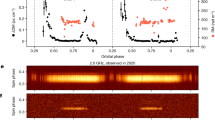Abstract
We have discovered a remarkable pulsar with period 1.6 ms, moving in a nearly circular 9.17-h orbit around a low-mass companion star. At an observing frequency of 430 MHz, the pulsar, PSR1957 + 20, is eclipsed once each orbit for about 50 minutes. For a few minutes before an eclipse becomes complete, and for more than 20 minutes after the signal reappears, the pulses are delayed by as much as several hundred microseconds—presumably as a result of propagation through plasma surrounding the companion. The pulsar's orbit about the system barycentre has a radius of 0.089 light seconds projected on to the line of sight. The observed orbital period and size, together with the fact that eclipses occur, imply a surprisingly low companion mass, only a few per cent of the mass of the Sun.
This is a preview of subscription content, access via your institution
Access options
Subscribe to this journal
Receive 51 print issues and online access
$199.00 per year
only $3.90 per issue
Buy this article
- Purchase on Springer Link
- Instant access to full article PDF
Prices may be subject to local taxes which are calculated during checkout
Similar content being viewed by others
References
Rawley, L. A., Taylor, J. H., Davis, M. M. & Allen, D. W. Science 238, 761–765 (1987).
Hankins, T. H., Stinebring, D. R. & Rawley, L. A. Astrophys. J. 315, 149–153 (1987).
Author information
Authors and Affiliations
Rights and permissions
About this article
Cite this article
Fruchter, A., Stinebring, D. & Taylor, J. A millisecond pulsar in an eclipsing binary. Nature 333, 237–239 (1988). https://doi.org/10.1038/333237a0
Received:
Accepted:
Issue Date:
DOI: https://doi.org/10.1038/333237a0
This article is cited by
-
Searches for continuous-wave gravitational radiation
Living Reviews in Relativity (2023)
-
A 62-minute orbital period black widow binary in a wide hierarchical triple
Nature (2022)
-
Millisecond Pulsars, their Evolution and Applications
Journal of Astrophysics and Astronomy (2017)
Comments
By submitting a comment you agree to abide by our Terms and Community Guidelines. If you find something abusive or that does not comply with our terms or guidelines please flag it as inappropriate.



